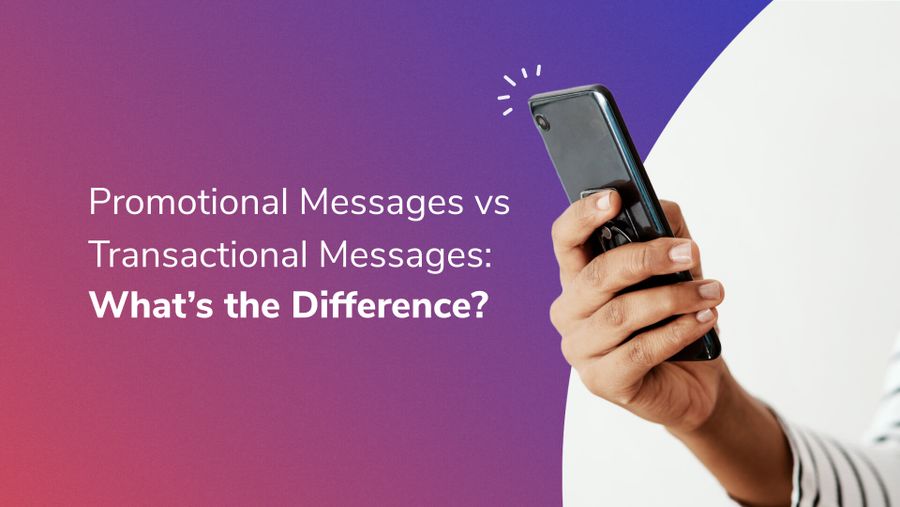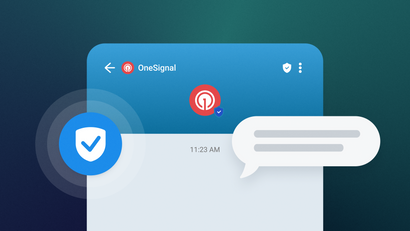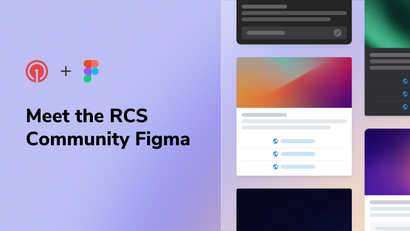What’s the difference between a transactional message and a promotional message?
Let’s break it down and explore some examples.
When are Transactional Messages Sent?
Transactional messages are necessary and urgent communications to your end users or customers.
Successful transactional messages reduce friction by making important information available at the moment a user needs it most, which in turn enhances the customer experience. Transactional messages can come in the form of push notifications, text messages, emails, and more.
The key purpose of transactional messaging is to provide direct utility or serve a necessary purpose in the customer journey. Unlike marketing messages, transactional notifications are generally expected and needed by their recipients.
Without transactional messages, your user may miss key information and their experience can become fragmented. Examples of transactional messages include authentication emails, delivery updates, shipping confirmations, account balance alerts, and password reset messages.
Transactional notifications take different forms across industries and channels.
Examples
eCommerce
For example, clothing resale app Curtsy sends a string of transactional messages to customers after they’ve placed an order, so that they can track their item’s journey from start to finish until it arrives safely at their house.
They use push to share order tracking information, send alerts to ensure that sellers ship orders on time, notify users about messages they’ve received, and to provide recommendations to help move inventory.
“This [push notifications] was a day-one need for us — we needed transactional notifications in order for that process to work. Traditional companies use email for transactional messages. Since we’re a mobile-first company, we need push notifications.”
Telehealth
Within the health industry, transactional messaging is paramount to patient-provider relationships, proper treatment, and adherence to behavioral medication-related regimens.
When Project Rōnin built a mobile app to help patients track symptoms between visits and communicate with their care team, they needed to implement a range of transactional messages to encourage in-app symptom tracking and coordinate cross-channel communication between patients and clinicians.
They now use OneSignal’s segmentation and personalization capabilities in order to deliver personalized transactional messages at scale to users in different treatment cohorts.
Two key transactional use cases for their app include sending mobile push to remind cancer patients to report symptoms between appointments and using in-app messages to educate users about their treatment regimens.
Crypto
Bitcoin Wallet is a mobile application designed to help users buy, sell, trade, and securely store cryptocurrency using encryption techniques.
As with any financial app, real-time transactional push notifications are imperative to Bitcoin’s app experience. In order for users to manage their funds and trade with confidence, they need to know when funds move even after they close the app.
Personalizing and automating these notifications requires touching personally identifiable information (PII) and sensitive financial data, so privacy and security are critical.
To ensure the utmost privacy and accuracy of notifications, Bitcoin uses OneSignal’s robust API to automate and personalize these transactional push messages at scale.
Growth Product Manager Daria Dovzhikova explains,
“When a person sends some significant amount of crypto, they wait patiently to get an alert about that…it’s crucial functionality and we love to avoid any manual work here.”
What are Promotional Messages?
Promotional messages are generally sent for marketing purposes, rather than logistical purposes. They can be used to draw attention to sales, seasonal deals, or new product releases. In sending promotional messages, brands must take care in the content type, frequency, and tone of their messages in order to avoid irritating users.
Examples
Multimedia and Design Software
Music creation platform Rapchat uses a variety of channels to send promotional messages in order to increase their subscription retention.
They use push, email, and in-app channels to promote their free trial offering in order to give this promotional maximum visibility. Using in-app messages and email in addition to push notifications increases the chances that a user will convert on an offer.
They also incentivize subscription upgrades by sending well timed offers, such as holiday discounts, via multiple channels.
Fitness and Health
Our client BetterMe uses push notifications for both transactional and marketing use cases. However, they’ve found incredible success with their promotional push campaigns in driving direct conversions on their platform.
By promoting upsells in a way that was personal and contextually relevant to each user’s behavior, they doubled their conversion rate for in-app challenges and doubled their total in-app purchases — a whopping 100% performance increase.
Food Delivery
Our client Shake Shack uses a combination of in-app and push messages for promotional purposes in order to advertise both local and nationwide promotions.
During the Superbowl, the company was running a ten dollar discount for orders placed in the app on gameday. To promote this message, Shake Shack distributed the message across both channels to reach a broader audience.
By using both channels at the same time, they were able to engage with more users, including those who hadn't subscribed to push. They incentivized orders with a flashy in-app message, which contained a vibrant design and order button. The message received over 37 thousand impressions and a 20 percent click-through rate.
They took the same approach when they announced the release of a new milkshake in partnership with an award-winning bakery. Using push and in-app to foreshadow the drop of the new drink, their in-app message received an impressive 5 thousand impressions and a 52 percent click-through rate.
Consent Frameworks for Transactional and Promotional Messages
When it comes to establishing consent, some channels require different protocols for transactional and marketing messages. Here’s a brief overview of how to establish consent for each marketing channel.
Push Notifications
For the mobile push channel, user permission is required to send messages of both a transactional and promotional nature. In order to gain users’ permission to send them push messages through this channel, you’ll need their explicit opt in on iOS devices, and their implied permission on Android devices, although this protocol may well be changing as of Android 13.
Currently, on devices running on iOS require users to respond to Apple’s native permission prompt before your company can send them alerts from your app.
Devices running on Android currently don’t require an explicit opt-in. Rather, users are simply subscribed to this channel have the option to unsubscribe in their Settings on a per app basis. However, Android 13’s release may require users to opt into Android push notifications similarly to how they must opt into iOS notifications.
In the world of email marketing, it’s considered best practice to separate out your marketing and transactional messages by sending them with different dedicated IP and subdomain combinations. This way, your high-priority transactional emails are assured to reach a subscriber’s inbox without a hitch. You don’t want to risk lumping your transactional emails in with your marketing messages, since these promotional messages are more likely to get blocked or delayed, which in turn can put your higher priority messages at risk.
Legally, your recipients must provide opt in consent to receive your promotional emails. Compliance requirements vary by region, but it’s wise to ensure compliance according to the most stringent email privacy framework at play—the GDPR.
The GDPR requires that companies receive opt-in consent from recipients before sending marketing emails and that they keep records of that consent. Opt-in consent refers to an agreement that is signaled by a clear affirmative action and that is “freely given, specific, informed and unambiguous.”
In gaining opt-in consent, your company must separate email consent from other services or actions. It can’t be lumped in with terms and conditions or privacy notices, for instance.
Make sure that you obtain consent through a positive opt-in, like the active checking of a box, rather than using a pre-checked box.
Also important to note is that explicit consent for email requires declaration that clearly outlines what you’ll do with a consumer’s data and expresses what types of materials they can expect to receive. In this statement, you need to add information on any third parties you share data with, such as your email provider.
SMS (Text Messaging)
SMS consent is the same for promotional and transactional messages.
SMS requires an opt in process that’s distinct from other channels. Customers must agree to receive your texts via a different channel to respect compliance standards issued by the Telephone Consumer Protection Act (TCPA).
Before deploying SMS, you’ll need to gain users’ opt-in and provide a simple and direct method of opting-out in accordance with compliance regulations. To earn SMS opt-ins, mobile companies can capture phone numbers by prompting users to sign up for text messages when they subscribe to receive updates on another channel, such as email, or through web pop-ups.
Create a Free OneSignal Account and Send Messages Today
OneSignal is designed to help you send notifications and seamlessly manage your user communication across various channels, including mobile push notifications, web push notifications, bulk SMS, in-app messaging, and email. Our platform is quick to set up and makes it easy to send eye-catching messages without doing any development work. If you don't have a OneSignal account, you can create one for free and start sending push notifications to your users today. Don't take our word for it — simply sign up and see for yourself!
Create a Free Account



